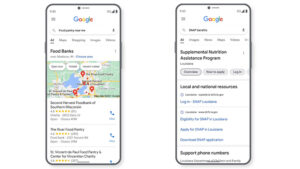Between Thanksgiving and New Year, searches for food banks and pantries spike on Google. In fact, for more than a decade, search interest on Google for “food bank” and “food pantry” queries spikes by 30-50% every November.
To help people find food and give back this holiday season, we’re announcing a number of new features:
Food Bank Locator on Google Search and Maps:
- We are working with WhyHunger and Hunger Free America to add or update location and key information for food banks and pantries to Google Search and Maps. We’re vetting and verifying the 24,000 food bank and pantry listings in Google Maps and Search. To help keep this information up to date, a team of more than 100 Googlers spent more than 7,000 hours on the phone to help verify Google Maps listings.
- Food banks, pantries and soup kitchens can also make use of new Google My Business features we’ve developed specifically for them to highlight hours of operation, services, types of donations accepted at their location and appointment availability where aplicable.
Supplemental Nutrition Assistance Program Information Panels:
- Federal benefits programs like the Supplemental Nutrition and Assistance Program (SNAP) feed more than 40 million Americans each year. From today, if you search for “SNAP benefits,” or the name of your local SNAP program, you’ll find direct links to each state’s eligibility guidelines and application process, as well as contact information for local food assistance agencies.
EBT Payment Option
- Users can search for “stores that accept EBT near me” and find a list of grocery, convenience stores and farmers markets nearby that accept EBT as a payment method.
Since the beginning of the COVID-19 pandemic, Googlers have contributed more than $20 million in personal donations and company matches to food banks and pantries around the world. We’re announcing that Google is also contributing $1M in financial support ($50K to each) to 20 innovative food pantries, food banks, and food assistance organizations.
Even those who aren’t in need of these resources can still use Google Maps to make a difference in the lives of others who do. Local Guide Ashley Sundquist uses Google Maps to source information and build helpful lists to drive awareness of available community resources – from local shelters to community food banks – to make them more accessible for those in need. She’s provided tips for gathering, curating and sharing essential information about community resources on Google Maps, which anyone can replicate.





